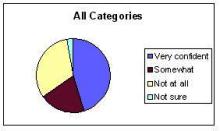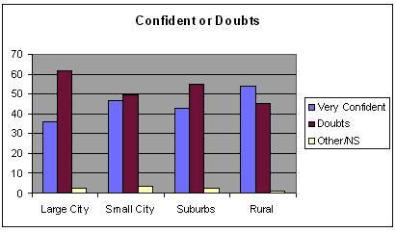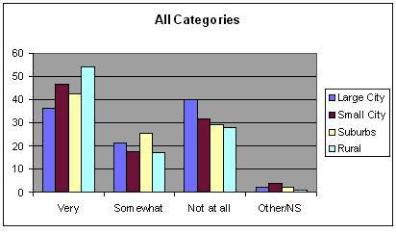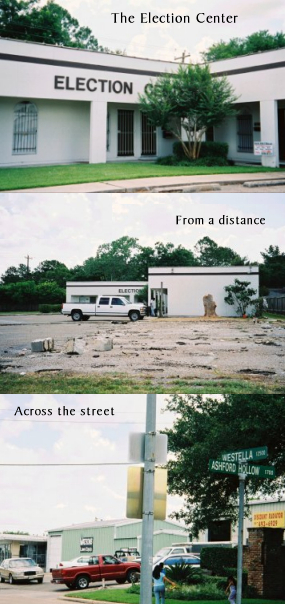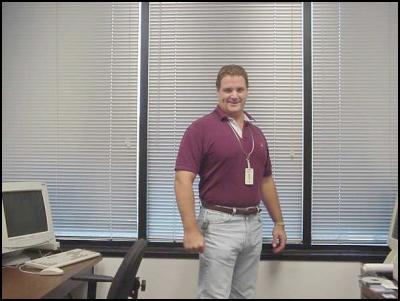Never Mind the ‘Results,’ Election 2006 Was a Disaster for E-Voting Systems Across the Nation
Posted in '06 Election, Black Box (Electronic) Voting, Brad Blog, Disenfranchisement, General, TAKE ACTION! on November 11th, 2006by Brad Friedman of The BRAD BLOG for ComputerWorld.com
Opinion: E-voting transition a disaster
A smooth transition to electronic balloting? Not so fast, America
November 10, 2006 (Computerworld) —
ELECTRONIC VOTING MACHINE SLAYS NINE
Terrorizes Florida in Thrill-Kill Rampage
That headline was from a satirical column written by Andy Borowitz published last Monday, the day before Tuesday’s midterm elections. Unfortunately, given the post-election coverage by some of the nation’s leading media — or at least their headline writers — it seems that only an event such as a Diebold voting machine becoming “unmoored from the floor and…trampling everyone and everything in its path,” as Borowitz wrote, would qualify as anything more than a “glitch,” “hiccup,” “snag” or “snafu.”
“Voting System Worked, With Some Hiccups,” declared the AP headline on Wednesday. “Polling Places Report Snags, but Not Chaos,” echoed The New York Times. “Hiccups”? “Snags”? Try telling that to the thousands of voters around the country who were unable to simply cast a vote last Tuesday because new, untested electronic voting machines failed to work. Monumentally. Across the entire country.
“Not Chaos”? Apparently the Times headline writers failed to check with the folks in Denver who were lined up around the block for hours to vote. They didn’t even bother to read the Denver Post article headlining the problem as a “Voting Nightmare” during the day on Tuesday and quoting voter Lauren Brockman saying, “We will not get to vote today,” after he had shown up before work to vote at 6:45 a.m. at the Botanic Gardens only to wait on line for an hour before giving up.
They didn’t check with Bill Ritter, the Colorado gubernatorial candidate, who had to wait almost two hours to vote, or with Sean Kelley, a Denver resident, who said to the Post, “I can’t believe I’m in the United States of America,” before he gave up and went home without voting after waiting three hours in line when electronic machines broke down. Despite an emergency request, the courts in Colorado refused to allow the city’s new consolidated “Election Centers” to remain open for extra hours that night.
Similar problems led to slightly more responsible officials ordering polls to be kept open longer than scheduled in at least eight other states due to voting machine problems.
In a Times story published the day before (which apparently the headline writers of the previously mentioned piece failed to read), it was reported that in Illinois “hundreds of precincts were kept open … because of late openings at polling places related to machine problems” and in Indiana “voting equipment problems led to extensions of at least 30 minutes in three counties.”
Other states where polls remained open late due to the inability of legally registered voters to vote when they showed up earlier in the day include Pennsylvania, South Carolina, Ohio, Georgia, North Carolina, Indiana and Ohio.
But the list of problems and, yes, meltdowns is still pouring in from around the country. My in-box has been beyond readability since polls opened on Tuesday morning, and my ability to keep up had already been near the breaking point in the weeks prior just from similar reported disasters that occurred with these failing, flipping and flimsy machines during the early voting period in Florida, Arkansas, Missouri, Ohio, Tennessee, Virginia, Texas and California, just to name a few.
On Election Day, the Electronic Frontier Foundation had received about 17,000 complaints on its toll-free hot line by 8 p.m. Common Cause received 14,000 calls by 4 p.m. John Gideon at VotersUnite.org performed the herculean task of logging as many news reports as he could in a searchable online database of reported election problems that day.
The nation dodged a significant bullet when George Allen conceded in his Virginia Senate race Thursday. Had he not chosen to do so, America would have found itself smack-dab in the middle of another Florida 2000 crisis with the balance of Congress depending on voting machines that offer absolutely no way to recount ballots to achieve any form of accuracy or clarity in the race. The battle of the forensic computer scientists trying to figure out what happened would have been another long national nightmare.
But that didn’t happen, so everything’s cool. Right?
We dodged another bullet when Sen. Rick Santorum conceded. Earlier in the day, he and the Pennsylvania Republican Party sent a letter to the secretary of the commonwealth demanding that voting machines in 27 counties be impounded after they received reports of touch-screen votes flipping from the Republican candidate to his Democratic opponent.
Imagine, by the way, if Democrats had taken such a responsible position to impound machines every time votes were reported to have flipped from Democrat to Republican — certainly the more commonly reported occurrence on Tuesday. There wouldn’t be a voting machine left in the country. It’s a pity the Democrats haven’t figured that out. Yet.
They’re so delighted to have won anything they haven’t stopped to realize they might have taken 40 seats in the House instead of just 30 had they bothered to fight for an accountable, secure, transparent electoral system and instructed their candidates to concede nothing until every vote was counted, verified and audited for accuracy.
And still, the Times and AP headline writers — who seem to have failed to read the stories they were headlining, given that each outlined a litany of such meltdowns — believe there’s nothing to be concerned about.
18,000 votes seems to have vanished into thin air via ES&S iVotronic touch-screen machines (no paper “trails,” much less countable paper ballots ) in Sarasota County, site of Florida’s 13th U.S. Congressional District contest between Vern Buchanan and Christine Jennings. There’s currently a 368-vote difference between them, but there’s no paper to to examine to figure out what may have gone wrong and explain how a 13% undervote rate was found in only in that race.
On the very same ballot above that race, the gubernatorial contest had only a 2.6% undervote rate. A hospital board election below it had only a 1% undervote rate. On absentee ballots for the Jennings/Buchanan race, the undervote rate was just 1.8%. Some of the 120 complaints from touch-screen voters that came into the Herald Tribune on Tuesday are published on the newspaper’s site.
18,000 undervotes. In Florida. With no paper ballots to go back and check to see if all of those voters simply chose not to vote in that race for some inexplicable reason. Faith-based voting in a race that Florida election officials in the secretary of state’s office have said they have no plans to investigate.
Good thing the balance of the U.S. House doesn’t hang on that race. Or a presidential election. But why worry about something like that? After all, a mere 18,000 disappeared votes on an electronic voting machine in a single county in Florida could never affect the outcome of a national presidential race. (Again, for the sarcasm-impaired: Right.)
In San Diego, thousands of hackable Diebold voting machines were sent home for three weeks prior to the election with poll workers (most of them apparently high-school teenagers hired by the county’s registrar of voters, Mikel Haas) on “sleepovers.” As Princeton University demonstrated, a hotel mini-bar key and just 60 seconds of unsupervised time with a single machine is just about all a single person would need to steal votes from every machine in the county. Nobody would ever be able to prove it. Thus, there is no basis for confidence in any reported results from any election this year in San Diego County. 50th Congressional District candidate Francine Busby has, so far, appropriately refused to concede despite the wide margin being reported in her race from the tainted, effectively decertified voting machines Haas disgracefully used for the first time this year across the entire county.
In Orange County, Calif., voters were turned away without being able to vote at all when machines failed to work and there were not enough paper ballots for voters to cast their votes. Many reportedly opted to vote on Chinese and Vietnamese ballots when English emergency paper ballots had run out (in places where they even had paper ballots to chose from), just so they could exercise their franchise. Many voters were simply told to “come back later,” when poll workers hoped the machines would be working again.
It is not yet a felony in the United States of America to turn a legally registered voter away from the polls without allowing him to cast a vote. But it damned well should be.
Victoria Wulsin currently trails Jean Schmidt by less than half a percentage point in their Ohio 2nd Congressional District race for the U.S. House. Wulsin has also appropriately refused to concede until every vote is counted, accounted for and verified. But a recount will rely on both the same hackable Diebold AccuVote TSx touch-screen machines used in San Diego and the same ES&S optical scan machines that were found to have mistabulated at least nine Republican primary races in Pottawatomie County, Iowa, last June.
Ten other House races still remain “too close to call.” Many of them will rely on “results” reported by inaccurate, unreliable, untested electronic voting machines.
Fortunately, the balance of the House doesn’t rest on any of those races either, so all is well.
When Warren Stewart of the nonpartisan VoteTrustUSA.org noted a number of Voting Machine Company apologists — from the U.S. Elections Assistance Commission’s Paul Degregorio to California’s unelected secretary of state, Bruce McPherson, to the Election Center’s Doug Lewis and ElectionLine.org’s Doug Chapin — joining the “everything’s fine” crowd, he noted:
They agree that the election went “better than expected,” “relatively smoothly,” with “isolated problems,” “just a few glitches,” “minor issues,” “no major problems.”
So, with multi-hundreds of news reports of election problems across the country — a fraction of the problems that actually occurred — you have to wonder what a meltdown would have to look like.
What would it look like, indeed?
I guess before the voting machine company flunkies and Times and AP headline writers would notice, it would have to look like Borowitz’ “Diebold Rampage” scenario. Though even that would likely have a predictable ending…
The touch-screen terror then cut a swath of death and destruction across the state, despite attempts by the state police to apprehend it.
Florida Gov. Jeb Bush appeared on television later in the day to urge calm, telling residents, “Clearly, Florida’s electronic voting machines are still very much a work in progress.”
At the White House, spokesman Tony Snow did not directly address the issue of the voting machine’s deadly rampage, choosing instead to make general remarks about the electoral process.
“This administration remains steadfast in its support of free and fair elections,” he said, adding, “in Iraq.”
by Brad Friedman of The BRAD BLOG for ComputerWorld.com



